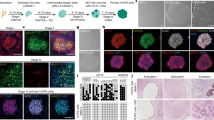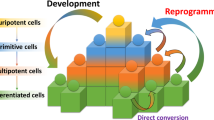Abstract
The slow kinetics and low efficiency of reprogramming methods to generate human induced pluripotent stem cells (iPSCs) impose major limitations on their utility in biomedical applications. Here we describe a chemical approach that dramatically improves (200-fold) the efficiency of iPSC generation from human fibroblasts, within seven days of treatment. This will provide a basis for developing safer, more efficient, nonviral methods for reprogramming human somatic cells.
This is a preview of subscription content, access via your institution
Access options
Subscribe to this journal
Receive 12 print issues and online access
$259.00 per year
only $21.58 per issue
Buy this article
- Purchase on Springer Link
- Instant access to full article PDF
Prices may be subject to local taxes which are calculated during checkout



Similar content being viewed by others
References
Takahashi, K. et al. Cell 131, 861–872 (2007).
Yu, J. et al. Science 318, 1917–1920 (2007).
Muller, L.U.W., Daley, G.Q. & Williams, D.A. Mol. Ther. 17, 947–953 (2009).
Feng, B., Ng, J.H., Heng, J.C.D. & Ng, H.H. Cell Stem Cell 4, 301–312 (2009).
Hay, E.D. Acta Anat. 154, 8–20 (1995).
Chen, S. et al. Proc. Natl. Acad. Sci. USA 104, 10482–10487 (2007).
Shi, Y. et al. Cell Stem Cell 2, 525–528 (2008).
Xu, Y., Shi, Y. & Ding, S. Nature 453, 338–344 (2008).
Watabe, T. & Miyazono, K. Cell Res. 19, 103–115 (2009).
Willis, B.C. & Borok, Z. Am. J. Physiol. Lung Cell. Mol. Physiol. 293, L525–L534 (2007).
Thiery, J.P. & Sleeman, J.P. Nat. Rev. Mol. Cell Biol. 7, 131–142 (2006).
Chou, Y.F. et al. Cell 135, 449–461 (2008).
Huangfu, D. et al. Nat. Biotechnol. 26, 1269–1275 (2008).
Aasen, T. et al. Nat. Biotechnol. 26, 1276–1284 (2008).
Zhou, H. et al. Cell Stem Cell 4, 381–384 (2009).
Acknowledgements
This work was supported by funding from US National Institutes of Health and Fate Therapeutics to S.D. We thank C.V. Wright (Vanderbilt University medical center) for the gift of Pdx1 antibody, R. Coleman for the assistance in the preparation of the manuscript and all the members of Ding lab for helpful discussions.
Author information
Authors and Affiliations
Contributions
T.L. and S.D. initiated the study. S.D., R. Am. and T.L. made the hypothesis, designed the experiments and wrote the manuscript. T.L., R. An, X.Y., H.S.H., and W.L. conducted the experiments. S.H., R. Ab. and X.L. provided assistance in some of the experiments. E.H. generated teratomas, and A.H. supervised E.H. S.D. supervised the study.
Corresponding author
Supplementary information
Supplementary Text and Figures
Supplementary Figures 1–4 and Supplementary Table 1 (PDF 732 kb)
Rights and permissions
About this article
Cite this article
Lin, T., Ambasudhan, R., Yuan, X. et al. A chemical platform for improved induction of human iPSCs. Nat Methods 6, 805–808 (2009). https://doi.org/10.1038/nmeth.1393
Received:
Accepted:
Published:
Issue Date:
DOI: https://doi.org/10.1038/nmeth.1393
This article is cited by
-
A rapid and stable spontaneous reprogramming system of Spermatogonial stem cells to Pluripotent State
Cell & Bioscience (2023)
-
TGFβ inhibition and mesenchymal to epithelial transition initiation by Xenopus egg extract: first steps towards early reprogramming in fish somatic cell
Scientific Reports (2023)
-
“Cutting the Mustard” with Induced Pluripotent Stem Cells: An Overview and Applications in Healthcare Paradigm
Stem Cell Reviews and Reports (2022)
-
A high throughput screening system for studying the effects of applied mechanical forces on reprogramming factor expression
Scientific Reports (2020)
-
Small-molecule-mediated reprogramming: a silver lining for regenerative medicine
Experimental & Molecular Medicine (2020)



